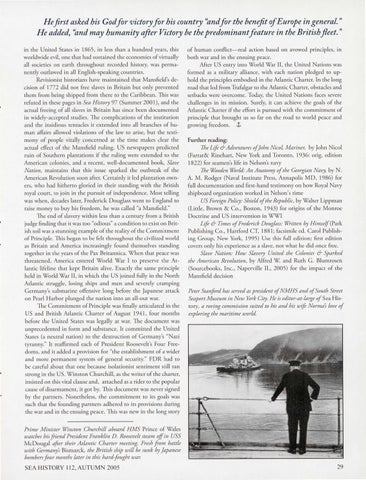He first asked his Godfor victory for his country ''andfor the benefit ofEurope in general." He added, ''and may humanity after Victory be the predominantfeature in the British fleet." in the United States in 1865, in less than a hundred years, this wo rldwide evil, one that had sustained the economies of virtually all societies on earth througho ut recorded hi sto ry, was permanently outlawed in all English-speaking countries. Revisionist historians have m aintained that Mansfield's decision of 1772 did not free slaves in Britain but only prevented them from being shipped from there to the Caribbean. This was refuted in these pages in Sea History 97 (S ummer 2001), and the actual freeing of all slaves in Britain has since been documented in widely-accepted studies. The complications of the institution and the insidious tentacles it extended into all branches of human affairs allowed violations of the law to arise, but the testimony of people vitally concerned at the time makes clear the actual effect of the M ansfield ruling. US newspapers predicted ruin of Southern plantatio ns if the ruling were extended to the American colonies, and a recent, well-documented book, Slave Nation, maintains that this issue sparked the outbreak of the American Revoluti on soon after. Certainly it led plantation owners, who had hitherto glori ed in their standing with the British royal court, w join in the pursuit of independence. Most telling was when, decades later, Frederick Douglass went to England to raise money to buy his freedom , he was called "a Mansfield." The end of slavery within less than a century from a British judge finding that it was too "odious" a condition to exist on British soil was a stunning examp le of the reality of the C ommitment of Principle. This began to be felt throughout the civilized world as Britain and America increas ingly found themselves standing together in the years of the Pax Britannica. When that peace was threatened, America entered World War I to preserve the Atlantic lifeline that kept Britain alive. Exactly the same principle held in World War II, in which the US joined fully in the North Atlantic struggle, losing ships and men and severely cramping Germany's submarine offensive long before the Japanese attack on Pearl Harbor plunged the nation into an all-out war. The Commitment of Principle was finally articulated in the US and British Atlantic C harter of August 194 1, four months before the United States was legally at war. The document was unprecedented in form and substance. It com mitted the United States (a neutral nation) to the destruction of Germany's "Nazi tyranny." It reaffirmed each of President Roosevelt's Four Freedoms, and it added a provision for "the establishment of a wider and more permanent system of general security." FDR had to be careful abo ut that one because isolationist sentiment still ran strong in the US. Winston Churchill, as the writer of the charter, insisted on this vital clause and, attached as a rider to the popular cause of disarmament, it got by. This document was never signed by the partners. Nonetheless, the commitment to its goals was such that the founding partners adhered to its provisions during the war and in the ensuing peace. This was new in the long story
of human conAict-real action based on avowed principles, in both war and in the ensuing peace. After US entry into Wo rld War II, the United Nations was formed as a m ilitary alliance, with each nation pledged to uphold the prin ciples embodied in the Atlantic Charter. In the long road th at led from Trafalgar to the Atlantic Charter, obstacles and setbacks were overcome. Today, the United Nations faces severe challenges in its mission. Surely, it can achieve the goals of the Atlantic C harter if the effort is pursued with the commitment of principle that brought us so far on the road to world peace and growing freedom. J, Further reading: The Life & Adventures ofjohn Nicol, Mariner, by John Nicol (Farrar& Rinehart, New York and Toronto, 1936: orig. edition 1822) for seamen's life in Nelson's navy The Wooden World: An Anatomy of the Georgian Navy, by N. A. M. Rodger (Naval Institute Press, Annapolis MD, 1986) for fu ll docum entation and first-hand testimony on how Royal Navy shi pboard organization worked in Nelson's time US Foreign Policy: Shield ofthe Republic, by Walter Lippman (Little, Brown & Co., Boston, 1943) for origins of the Monroe Doctrine and US intervention in WWI Life & Times ofFrederick Douglass: Written by Himse/f(Park Publishing Co., Hartford CT, 188 1; facsimi le ed. Carol Publishing Gro up, New York, 1995) Use this full edition; first edition covers only his experience as a slave, not what he did once free . Slave Nation: How Slavery United the Colonies & Sparked the American Revolution, by Alfred W. and Ruth G . Blumrosen (Sourcebooks, Inc., Naperville IL, 2005) for the impact of the Mansfield decision
Peter Stanford has served as president ofNMHS and ofSouth Street Seaport Museum in New York City. He is editor-at-large of Sea History, a roving commission suited to his and his wife Norma's love of exploring the maritime world.
Prime Minister Winston Churchi!! aboard HMS Prince of Wales watches his friend President Franklin D. Roosevelt steam off in USS McDougal after their Atlantic Charter meeting. Fresh from battle with Germany's Bismarck, the British ship will be sunk by Japanese bombers fou r months later in this hard-fought war.
SEA HISTORY 112, AUTUMN 2005
29
